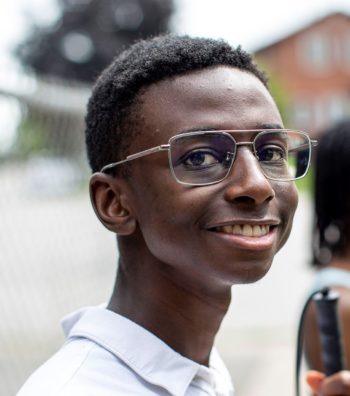How a Pickering teen with a rare eye disease is using TikTok to flip the script on visual impairment
Adam Brown hopes to show people what living with retinitis pigmentosa looks like
Laura Tennant,
Oct 29 2021 Adam sees a future for himself as an advocate and hopes his videos will help people better understand what visually impaired people are able to do. While he is legally blind, Adam has some vision, and he is able to read and use a smartphone. NICK KOZAK
Adam sees a future for himself as an advocate and hopes his videos will help people better understand what visually impaired people are able to do. While he is legally blind, Adam has some vision, and he is able to read and use a smartphone. NICK KOZAK
For 18-year-old Adam Brown, visual impairment has always been a part of life. “I’ve had retinitis pigmentosa since birth,” he says.
Retinitis pigmentosa is a term used to describe a group of genetic disorders that damage photoreceptors, the light-sensitive cells in the eye. This causes visual impairment. The disease is progressive, meaning it tends to get worse over time. Usually, the first photoreceptors affected are the rod cells, which are responsible for night and peripheral vision. Over time, the cone cells, responsible for colour vision, central vision and seeing fine details, are also affected. Retinitis pigmentosa is an inherited genetic disorder, so it often runs in families.
Adam’s 21-year-old sister Jenna also has the disease. In the Brown family’s case, however, the kids’ diagnosis came as a complete surprise.“We didn’t know of anyone in our extended families that had this disease,” Adam’s mother Charmain says.While Adam has been legally blind since birth, he has not let that stop him from doing the things he wants to do.Today, he’s an advocate for the visually impaired, sharing his experience in the hopes of raising awareness.Adam uses TikTok to discuss being visually impaired and some of the challenges he’s facing accessing treatment for his condition. In March 2021, one of his videos went viral, garnering over 450,000 likes.For the Brown family, this was overwhelmingly encouraging. “It was a pretty great experience,” Adam says.
Charmain says she is thrilled that Adam is an advocate for the condition, adding that she thinks his videos have a positive impact.“There’s a lot of stereotypes and bias around what having a visual impairment looks like on a person,” she explains. “So I think part of [the video’s success] is breaking down the stigma, breaking down the stereotypes.”“You don’t have to look different to have a visual impairment,” she adds.
Adam’s videos tend to challenge viewers’ assumptions about visually impaired people. Many of the comments remarked that Adam’s visual impairment wasn’t immediately obvious, because his eyes were open and he looked “normal”, the family says.
“That was my favourite part of the whole thing, because it honestly felt like I was leading a movement, like I was spreading awareness of something that a lot of people didn’t really know about,” Adam says.Adam sees a future for himself as an advocate and hopes his videos will help people better understand what visually impaired people are able to do. While he is legally blind, Adam has some vision, and he is able to read and use a smartphone. Adam Brown, right, has had retinitis pigmentosa since birth, as has his sister Jenna, left. Adam’s mother Charmain, middle, is thrilled that her son has become an advocate for people with the disease. NICK KOZAKAdam’s success has, in part, to do with the tireless work his parents did to support him and Jenna as they grew up.
Adam Brown, right, has had retinitis pigmentosa since birth, as has his sister Jenna, left. Adam’s mother Charmain, middle, is thrilled that her son has become an advocate for people with the disease. NICK KOZAKAdam’s success has, in part, to do with the tireless work his parents did to support him and Jenna as they grew up.
“When you’re planning for a family, you don’t plan for this,” Charmain says. “So when the diagnosis came, it was a complete shift in our thinking of what our [children] will be able to do.”The questions were endless, she says. “What will they become? What will they be like? How will they interact? How will I interact with them?” Charmain and her husband Kedar say they had to think about their children’s lives in a different way to be able to answer those questions. Over time, they realized their kids would be able to do things that all the other kids are able to do, “but it will look different,” she says.
Inherited blinding eye diseases can be costly for families. It has been estimated that inherited retinal dystrophies have a socio-economic burden of up to 1.6 billion CAD in one year, according to a recent study. The diseases have a significant impact on the wellbeing of both patients and family members, which may account for up to two-thirds of the total costs.In the years following the children’s diagnosis, the Brown family dedicated themselves to gathering the right resources to help support their kids.One of those resources was a clinical trial in the U.S. that Jenna was able to participate in.
Unfortunately, time is not on Adam’s side. He continues to lose vision with each passing day with the progressive loss of photoreceptors, which can ultimately lead to complete visual impairment. The Brown family hopes their bright young son will someday have a better quality of life. For his part, Adam plans to continue using his platform to raise awareness about inherited retinal diseases and flipping the script for what visual impairment looks like.“ The fact that I was able to educate people in any way, that’s amazing to me.”
For more information on retinitis pigmentosa and visual impairment, please visit Fighting Blindness Canada .
This story was created by Content Works , Healthing.ca’s commercial content division, on behalf of a research-based pharmaceutical company.

